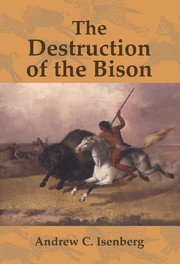4 - The Ascendancy of the Market
Published online by Cambridge University Press: 05 August 2012
Summary
In the middle decades of the nineteenth century, the nomadic societies of the western plains encountered a new wave of Euroamerican ecological and economic expansion. The eighteenth-century invasion had levered the mounted bison hunters to dominance in the western plains; the renewed incursion of the nineteenth century devastated both the nomads and the bison. In part, the social and environmental catastrophe of the mid-nineteenth century resulted from the scale of the invasion. The bison robe trade of the American Fur Company far exceeded the commerce in beaver pelts of the eighteenth-century voyageurs. The smallpox that ravaged the inhabitants of the western plains between 1837 and 1840 was more virulent than the epidemic of 1780 to 1782. Yet the extensive economic and environmental changes in the western plains in the mid-nineteenth century were not simply the product of exogenous forces, however powerful. Social changes that had attended the nomads' transition to mounted bison hunting in the eighteenth century contributed to their receptivity to trade in the mid-nineteenth century and therefore to the depletion of the bison and the spread of disease.
Steamboats began to ascend the Missouri River to tap the labor and resources of the western plains in the early 1820s. In 1832, an American Fur Company steamboat reached the mouth of the Yellowstone River in the northern plains.
- Type
- Chapter
- Information
- The Destruction of the BisonAn Environmental History, 1750–1920, pp. 93 - 122Publisher: Cambridge University PressPrint publication year: 2000



